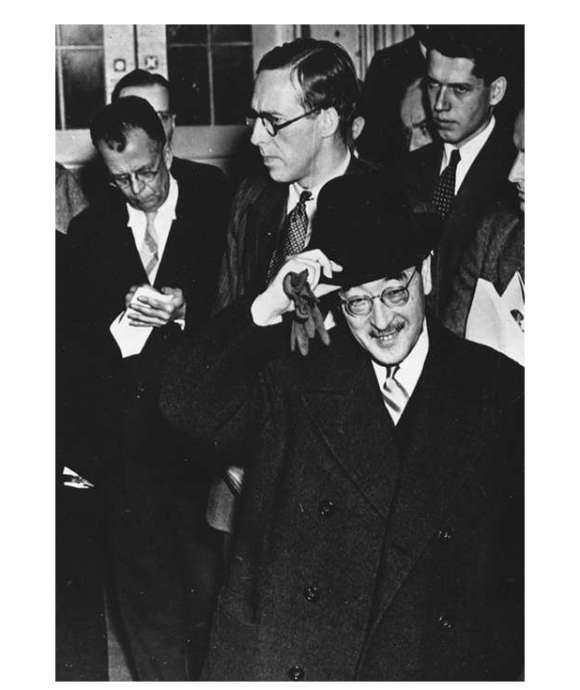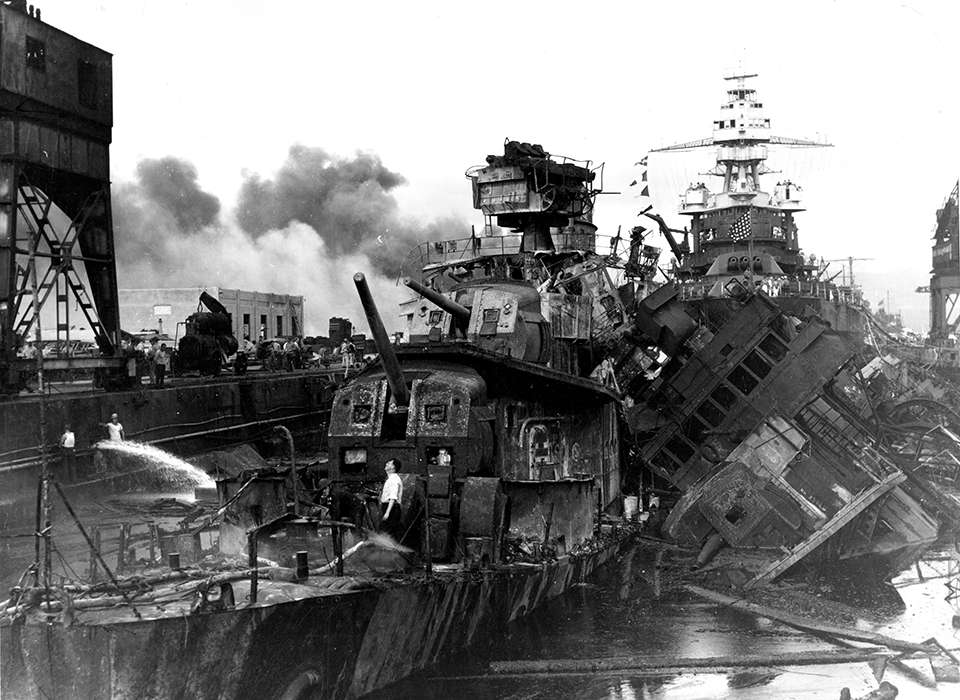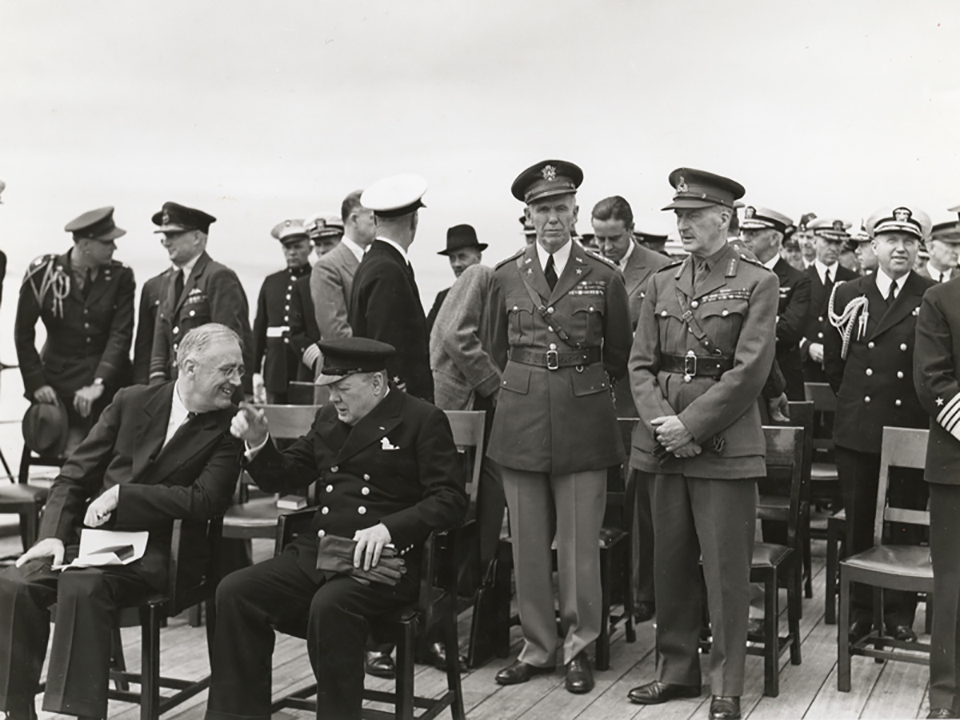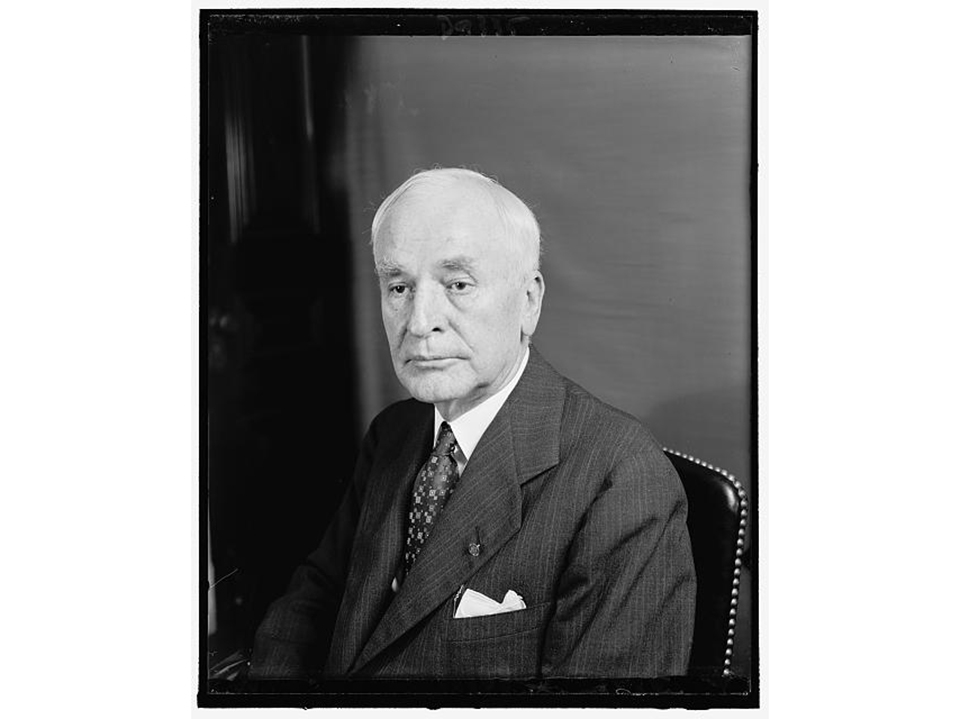Top Image: USS Downes (DD-375) and USS Cassin (DD-372), in a drydock at the Pearl Harbor Navy Yard, December 7, 1941. Both ships were severely damaged by the Japanese attack. From the Naval History and Heritage Command.
US Ambassador to Japan Joseph Grew met Franklin Roosevelt when they were boys enrolled at the elite Groton School. Unlike other government officials, Grew exercised the privilege of addressing letters to the President: “Dear Frank.” In December 1940, Grew asked for Roosevelt’s views on “Japan and all her works.” Roosevelt replied: “I believe that the fundamental proposition that we must recognize is that the hostilities in Europe, in Africa, and in Asia are all parts of a single world conflict.” This statement not only captures Roosevelt’s recognition of the connection between all the components of the global war, but also it guides our understanding of what brought about the Pearl Harbor attack. It was not the result of “the back door to war” theory that the Roosevelt administration connived to provoke Japan to attack the United States to achieve the ultimate goal of getting the United States into war with Germany. The true roots of the attack grew from recognition that keeping the Soviet Union in the war with Hitler required the United States not to bow to Japanese demands for the United States to abandon China.
When the German onslaught against the Soviet Union began on June 22, 1941, Washington and London both expected an inevitable Soviet collapse—just as all of Hitler’s targets to date had surrendered save, by a small margin, Great Britain in 1940. The US War Department projected the Soviets would last from one to three months. Expectations in London were similar.
Neither Germany nor the Soviets permitted foreign observers to conduct direct, independent views of the titanic struggle. The dueling daily communiques from Berlin and Moscow provided the only open information on what soon was termed the Eastern Front. The New York Times, as it did throughout the war, printed the communiques of all the belligerents each day on page two, often with helpful maps. The daily depictions in the communiques of the battlefield results seldom bore any agreement. Over a period of days or weeks, the sole data point on which Berlin and Moscow roughly agreed was the location of the fighting. This validated German claims of deep penetrations into the Soviet Union until abruptly, in the last ten days of July, the communiques confirmed the German onslaught was halted. We know now this was due to a combination of ferocious fighting by the Red Army (although with staggering casualties) that was wearing down the cutting edge of the German Army and colossal German logistical miscalculation. But Washington and London grasped for the first time that the Soviets might survive.
Roosevelt and British Prime Minister Winston Churchill immediately recognized Soviet survival would be of supreme strategic importance. But the British were overstretched and the United States unready to do much in the way of material support of the Soviets in 1941. Further, huge logistical hurdles stood between the desire to deliver material aid to the Soviets in 1941 and actual timely arrival. Washington and London identified one vital contribution they could render the Soviets: keep Imperial Japan from entering the war against the Soviet Union and potentially delivering a knock-out blow. Japan was ensnarled in a quagmire in China and this constituted the foremost impediment to a Japanese attack on the Soviets. Thus, keeping China in the war was vital to Soviet survival.
Coinciding with the halt of the German offensive into the Soviet Union was Japan’s occupation of southern Indochina in late July 1941. Although the Japanese claimed this furthered their war in China, this transparently was not so. Unlike northern Indochina, which did provide a logistical route to support China until Japanese occupation in July 1940, there was no such connection between southern Indochina and the Sino-Japanese war. The move was, however, obviously intended to give Japanese forces a springboard to attack British, Dutch, and American possessions in the Far East.
The Japanese advance brought Roosevelt to a critical decision. The United States was supplying about 75 to 80 percent of Japan’s petroleum. This fueled the Japanese economy and the war in China. Powerful currents of US public opinion calling for sanctions against Japan due to the horrific stories and images emerging from China had beset the Roosevelt Administration. Roosevelt had walked a tightrope between responding to public opinion by cutting off supplies of potential enhancements of Japan’s war making capabilities like aircraft and scrap iron, but he had steadfastly rejected cutting off petroleum. He feared Japan would react to the cutoff by swooping down and seizing the abundant petroleum sources in the Dutch East Indies (now Indonesia). Roosevelt did not believe the American public would support a war to rescue a European colonial possession in the Far East. The Japanese would thus obtain an alternate source of oil fortifying their strategic position and continue their war in China. Roosevelt did, however, now authorize what was initially intended as a flexible control system over petroleum exports to Japan in response to the direct threat to the US position in the Philippines. The intent was carefully calculated pressure to get Japan out of southern Indochina without provoking an attack on the Dutch East Indies.
President Franklin D. Roosevelt and British Prime Minister Winston Churchill aboard HMS Prince of Wales during the Atlantic Conference, August 10, 1941. From the Franklin D. Roosevelt Presidential Library and Museum.
This action coincided with the Atlantic Conference between Roosevelt and Churchill from August 9-12, 1941 on warships anchored in Placentia Bay, Newfoundland, Canada. Churchill brought with him Roosevelt’s most trusted aide, Harry Hopkins, who was fresh from a very candid interview in Moscow with Joseph Stalin. The Soviet dictator had imparted to Hopkins by far the most candid disclosures about the fighting to date, and he convinced Hopkins that he intended to fight on and survive. Soviet officials also urged Hopkins to have the United States issue a public declaration that if Japan attacked the Soviet Union, the United States would enter the war against Japan. Hopkins, of course, could give no such guarantee. But when he reported this to Roosevelt and Churchill, it was clear that keeping China in the war to tie down the Japanese was a shared objective in Washington, London, and Moscow. Following the Atlantic Conference, Roosevelt made the embargo on oil to Japan permanent.
From the perspective of Japanese leaders in Tokyo, the supreme strategic issue was extricating Japan from the China quagmire. News of Hitler’s attack on the Soviets prompted some Japanese army and naval officers to advocate that Japan join the attack. But elsewhere in the leadership there was wariness about taking on the Soviets unless they were plainly about to collapse as well as recognition that securing a supply of oil must take precedence over any action against the Soviets. Further, sober minds even in the Imperial Army also realized that without US oil, an immediate attack on the Soviets was impossible. The manifest connection between the cut-off of US petroleum and blocking a Japanese attack on the Soviets is a point much of the historical literature has ignored. The Japanese strategic debates in July accorded absolute primacy to ending the war in China. Below that came “Southern Operations” aimed to secure the oil of the Dutch East Indies. “Northern Operations” to enter the war against the Soviets dangled in standby status, only to be considered if the Germans were about to crush the Soviets.
Thus, the diplomatic negotiations between the United States and Japan between July and December 1941 pivoted around China. The Japanese placed two alternative demands before the United States. First, the United States cooperate with Japan to impose a peace treaty on China, ending the conflict in a clear Japanese triumph that Japan’s leaders could present to their people as justifying the sacrifices made for four years including nearly 200,000 battle deaths. The second or alternative demand was that the United States end all political, military, and economic support to China. The Japanese believed this must inevitably lead to the collapse of Chinese resistance.
In order to understand the Japanese diplomatic objectives, it is essential not only to read the bland official language of their written proposals, but to grasp what Japan sought with this language as divulged in the statements of Japanese diplomats in Washington and Tokyo and in decrypts of secret Japanese diplomatic cables. For example, on September 6, 1941 Japanese diplomats presented the formal Japanese note requiring that the United States “refrain from any measures or actions which will be prejudicial to the endeavor by Japan concerning the settlement of the China Affair.” Four days later, Japanese officials made clear to the State Department that these seemingly mild words required the United States withdraw all support for China.
Likewise, while by 1941 the US public strongly opposed Hitler and Germany, the public remained ambivalent at best about Joseph Stalin and the Soviet Union with many seeing them as twins morally. Roosevelt thus avoided publicly making an explicit link between the oil embargo and its role in sustaining China to support the Soviets. We do have solid evidence on the true foundation of his policy. William L. MacKenzie King, the Prime Minister of Canada, enjoyed close relations with both Churchill and Roosevelt. Indeed, the American president confided more to the Canadian than probably to any foreign leader apart from Churchill. After discussions with Roosevelt in early November, King wrote in his diary “A break in Chinese resistance will probably mean a break in Russian resistance.”
The other key figures who recognized the true engine of US policy were Japanese Ambassador Kichisaburō Nomura and Special Envoy Saburō Kurusu in Washington. Nomura fundamentally grasped as he put it in one message to Tokyo: “the United States will not favor us at the sacrifice of China.” Nomura and Kurusu realized the complete unreality of Tokyo’s pursuit of US abandonment of China. They also recognized events were careening swiftly towards war. In desperation, they extracted their own blend from a menu of terms Tokyo had provided. This essentially called for restoration of the status quo ante of July: Japan would withdraw from southern Indochina and the United States would restore the flow of oil. They presented this as Japan’s proposal on November 18.
When they reported this to Tokyo, they received a harsh rebuke and preemptory orders to withdraw the proposal and substitute another variant specifically requiring the US abandonment of China. When Nomura and Kurusu presented this to Secretary of State Cordell Hull on November 20, Hull demonstrated he understood the key Japanese demand was the abandonment of China. Hull asked the envoys what they thought the administration’s reaction would be to a demand to abandon Great Britain—in short, the United States would no more consider abandoning China than abandoning Great Britain.
Secretary of State Cordell Hull, photo taken in July 1940. Harris & Ewing photograph collection, Library of Congress Prints and Photographs Division.
Hull initiated a further exploration of diplomatic measures after this meeting. Drafts were transmitted to London. After reviewing them, Churchill responded in words that made clear his understanding of the vital importance of continued Chinese resistance: “There is only one point that disquiets us. What about Chiang Kai Shek? Is he not having a very thin diet. Our anxiety is about China. If they collapse our joint dangers would enormously increase.”
Then Hull read decrypted Japanese cables to the Washington envoys on November 24 disclosing not only that the United States absolutely must agree to abandon China, but also that the final deadline for this was November 28, just four days later. These cables coupled to the withdrawal of the terms presented by Nomura and Kurusu on November 18 made it clear to Hull the pointlessness of further diplomacy.
Hull then prepared what became labeled “The Hull Note” of November 26. Some histories present this as an “ultimatum,” not only breaking off what are depicted wrongly as ongoing and still hopeful negotiations, but also as forcing Japan to go to war. The “ultimatum” charge fails because it was marked “Strictly Confidential, Tentative and Without Commitment,” and it lacked both a deadline for acceptance and a threat that failure to accept it would result in war. What Hull intended, with the shameful Munich capitulation firmly in mind, was to state firmly for history the principled American position on all measures required to halt Japan’s aggression in Asia and sever her ties to Hitler’s Germany.
The “Hull Note” did cause glee among the militarists in Tokyo pressing for war with the United States. But the “Hull Note” was based on an accurate understanding that the negotiations could not possibly succeed, especially in the four days between November 24 and 28, because of the irreconcilable objectives of the United States and Japan over China’s global role in the anti-Axis coalition. Actual Japanese expectations can be judged by the fact that the Pearl Harbor attack force sailed on November 25, the day before the “Hull Note.”
The failure in much of the historiography to acknowledge the connections between Hitler’s attack on the Soviet Union and the recognition in Washington and London of the vital role of China in preventing Japan from striking what was feared to be the fatal blow to Soviet resistance is ultimately connected to a larger failure to acknowledge for decades the significance of China in the global conflict. The role of China was perhaps never greater in the whole war than the last months of 1941.

"Pretty Little Phrases": Japanese Diplomacy in 1945
Misguided Japanese diplomacy in 1945 helped to ensure that the war would not have a peaceful end.
Richard B. Frank
Richard B. Frank is an internationally renowned expert on the Pacific war and a guest contributor of the Museum for articles and "To the Best of My Ability" podcast.
Cite this article:
MLA Citation:
APA Citation:
Chicago Style Citation:











